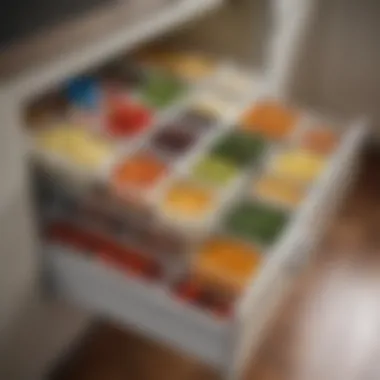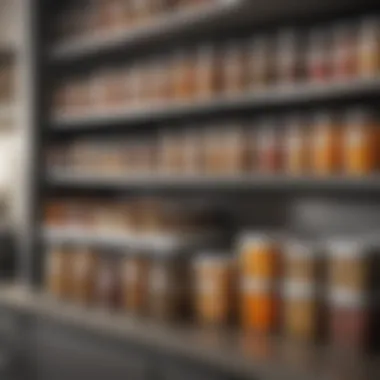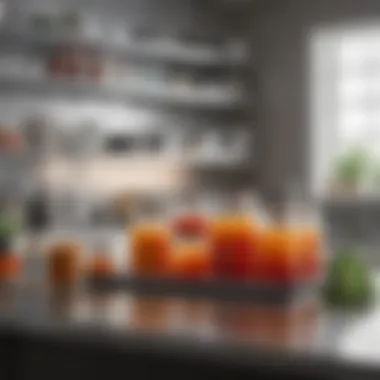Mastering Plastic Container Organization: Tips & Tricks


Intro
Organizing plastic containers is a common challenge in many kitchens. With various shapes and sizes, they can easily lead to clutter if not managed properly. Understanding how to streamline this aspect of kitchen storage is essential for an efficient cooking environment. This guide seeks to present various strategies for sorting and stowing away plastic containers effectively.
More than just arranging items, proper organization saves time and space. Busy individuals and families can benefit greatly from a more systematic approach to their kitchens. By applying the techniques discussed here, one can transform chaotic drawers and cupboards into orderly spaces. The aim is to simplify kitchen management while ensuring that everything is easily accessible.
As we dive deeper into this guide, we will explore different aspects of organizing these essential kitchen items. Topics, including categorization methods, various storage solutions, and maintenance tips, will be addressed. Each element outlined will assist readers in optimizing their kitchen space, enhancing both functionality and aesthetics.
Read on to discover practical techniques that will enable you to gain control over your plastic containers.
Understanding the Need for Organization
The kitchen serves as the heart of the home. It is where meals come to life, moments are created, and daily chaos often unfolds. Amid this whirlwind, organizing plastic containers plays a paramount role. Proper organization not only streamlines meal preparation but also enhances overall kitchen efficiency.
The Impact of Clutter on Kitchen Efficiency
A cluttered kitchen can lead to a host of inefficiencies. Every time a cook needs a container, they must sift through a disarray of mismatched lids and bases. This can result in frustration, wasted time, and even tears. Clutter distracts and can deter the joy of cooking if one feels marginalized by the space.
The inefficacy does not stop there; finding a good container can significantly hinder a cooking workflow. When everything is in disarray, a simple task such as meal prep can stretch longer than necessary. Montages of various ingredient preps become more time-consuming, and mistakes increase. Adopting a system to organize containers encourages a productive atmosphere, wherein everything is accessible and clearly visible.
Benefits of Organized Plastic Containers
Sifting through assorted sizes and types of plastic containers is exhausting. On the flip side, an organized system not just saves time, it also enhances the enjoyment of cooking. Here are a few notable benefits:
- Increased Efficiency: When containers are categorized and systematically stored, locating the right item takes mere seconds. This means more time for other culinary endeavors.
- Avoidance of Waste: An organized space allows one to see what is available, cutting down on duplicate purchases and minimizing the likelihood of expired items.
- Improved Aesthetics: A neat kitchen is visually appealing. This may lead to spending more time in a space that encourages creativity and interaction.
- Space Optimization: Consider how much valuable space could be serialized when containers are stacked efficiently or stored smartly. Utilizing vertical space, for instance, can create more room in an often cramped environment.
Maintaining an organized collection of plastic containers yields multifold benefits that transcend mere storage. Over time, such organization culminates into a more harmonious kitchen experience, ultimately promoting efficiency and encouraging culinary magic.
Assessing Your Plastic Container Collection
Assessing your plastic container collection is a crucial step in gaining control over kitchen organization. Recognizing what you have allows you to streamline your storage and make better use of your space. Moreover, it can save time and reduce frustration when searching for specific items during cooking or food preparation. An inventory helps in understanding storage capacity in your kitchen and identifies what can be discarded or repurposed. This clarity ultimately leads to a more efficient and tidy kitchen.
Inventory and Categorization
Organizing involves grouping similar items which results in a coherent system. Different approaches to categorization result in improved accessibility. As you assess your plastic containers, you will guide on how to determine which are the most useful for your daily activities.
Types of Containers
Types of containers greatly influence how you store food items. Plastic containers can vary widely, including options like trays, bowls, and sandwich boxes. Each type has distinct advantages. For example, bowls are often deeper, accommodating larger items, while trays work well for standard meal proof storage. The versatility these types of containers offer is beneficial for meal prep enthusiasts. However, they each have specific uses and fit differently within the organization plan.
The common features include colors, sizes, and shapes. Diversity in types allows for greater flexibility when creating meal portions or storing leftovers. Keep in mind the potential drawbacks: having too many different shapes may result in wasted space or difficulty in finding specific containers during your kitchen tasks.
Common Sizes and Shapes
Common sizes and shapes determine how efficiently you can stack and locate containers. Standard small, medium, and large offerings provide various options for meal preparation. Sizes play a pivotal role in organization, allowing for easy use and identification. A large container can hold bulk ingredients, while a small container works great for storing snacks.


Getting containers in common sizes also aids in maximizing space. They are often designed to fit snugly within each other. This nesting feature provides a streamlined aesthetic in your kitchen. However, the disadvantage can be size redundancy if too many similar containers are in use at the same time.
Material Considerations
The material composition of plastic containers influences not just the organization but also food safety and durability. Plastic container materials include polypropylene and polycarbonate. Each offers unique benefits. Polypropylene containers are generally microwave-safe, allowing for quicker meals, while polycarbonate may offer more durability when dropping or stacking.
Understanding these materials explains key benefits in maintaining organized plastic containers. However, there are noteworthy drawbacks, such as potential for staining or odor retention. Examining each material's characteristics allows for informed decisions, tailored to your cooking style and container usage.
Identifying Unused and Damaged Containers
When assessing your collection, identifying items that are no longer useful is equally important. Inspect all containers thoroughly for signs of wear. Monitor for cracks, scratches, or discoloration, which usually indicates expiration of their efficacy as kitchen tools. Clearing these items from your collection helps prevent overcrowded storage and promotes safety while cooking.
Engaging in a detailed purge will underscore better management of kitchen space. It sets a tone toward organizing new and practical options that align with both personal preference and functionality.
Strategic Organization Techniques
Strategic organization techniques play a crucial role in maximizing the utility of plastic containers within your kitchen. They offer structured methods to enhance functionality, minimize time spent searching for items, and contribute to a neater overall environment. Implementing these techniques can streamline your workflow, making food preparation and storage significantly more efficient.
Stacking and Nesting Strategies
Maximizing Vertical Space
Maximizing vertical space involves utilizing the height of your cabinets and shelves. This technique is critical as it allows for effective use of limited square footage. The essential characteristic of this strategy is its ability to transform cluttered spaces into organized havens. By stacking and nesting containers, you not only create more room but also ensure that everything is in sight and easily reachable.
The unique feature of this technique is that it enables keeping similar containers within the same stack. However, care must be taken to ensure that heavier items are lower and lighter ones are above. This presents a sturdy arrangement that enhances balance but can also have disadvantages. For instance, consistent stacking might lead to wear on some containers. Overall, it's a practical choice for a compact kitchen setting.
Using Lids Effectively
Using lids effectively improves not just organization but also extends the lifespan of your containers. The primary aspect of this is ensuring lids are matched with their corresponding containers, which saves a lot of time when needing an item. This tactical approach reduces the frequency of mismatched lids lying around.
The key characteristic of this element is that all containers can remain usable without adding chaos. The unique feature here is how an assigned area for lids, such as a lid organizer, works wonders. With the right set-up, you maximize lid storage while ensuring easy access. However, one drawback might be dedicating drawer space or additional shelving for this purpose. Yet, the benefits of a functional system widely outweigh this inconvenience.
Drawer and Shelf Organization
Utilizing Drawer Dividers
Utilizing drawer dividers simplifies reaching for your plastic containers. By creating designated sections within drawers, you prevent items from sliding around, creating hassle during usage. This efficiency enables a consistent layout that remains tidy regardless of how frequently the drawers are used. Typically, the components help you to categorize containers by size or function. This can be particularly beneficial within a busy kitchen where time is of the essence.
The unique feature of dividers is allowing you to compartmentalize chaos. On the other hand, the drawback could be the limitation in drawer usage when it comes to larger containers. Nonetheless, the improved access provided by organized drawers easily compensates for potential downsides in usage experience.
Optimizing Shelf Height
Optimizing shelf height ensures that accessible items are positioned at eye level. It relates directly to another organization principle that states design facilitates usage. Heights of shelves should be understandable, which means keeping frequently-used items within easy reach while storing less popular items higher.
This characteristic of enhancing accessibility makes it a popular choice for anyone looking to cut down on clutter. However, the unique feature of this method leans on how tailored it can be according to specific kitchen needs. Given some houses may yield smart-shelf systems that adjust heights; you will notice a marked impact. The only disadvantage comes if shelves are rearranged without maintaining a consistent system.


Employing Baskets and Bins
Grouping Similar Items
Grouping similar items in bins enhances organization by creating visual divisions. Each bin can represent a type or size of containers set aside. This method aids not only in access but also in creating a mental map of where objects live. The generative impact on space use is remarkable as it consolidates appearances.
A major characteristic is creating a categorized aesthetic, which is essential in any high-functioning kitchen. By doing so, you reinforce control over your environment. Yet, one possible downside os that doesn't immediately signal what items are in a bin unless inspected closely, which may slow accessibility.
Labeling for Easy Identification
Labeling bins or baskets fortifies organization in practical and engrossing forms. By tagging, you create smart visual cues that allow anyone to fetch items quickly while also avoiding mix-ups. The simple task of organization becomes pleasurable when it is marked clearly. Among professionals and enthusiasts alike, this strategy is valued, transforming locations ofsd bins into walking maps showing kitchen layout.
The unique feature of utilizing labels is that should be clear and easy to distinguish. It's beneficial but can waste time labeling each bin if several categories are added post-setup. Still, clear labels prove their worth and offer identifiable solutions, allowing continual efficiency in segmental aspects of kitchen storage.
Creating a Maintenance Routine
Establishing a maintenance routine is essential for ensuring the long-term organization of your plastic containers. A system that includes regular tidying and evaluation saves time later and maintains a functional kitchen. A structured approach keeps your storage areas efficient and clutter-free, especially for individuals or families who regularly cook and store food items.
Regular Cleaning and Inspections
Regular cleaning and inspections are crucial for maintaining your plastic containers. Over time, containers can accumulate stains, odors, or residues from various foods. This might lead to contamination, impacting the quality of your food storage. Here are some key points:
- Schedule Regular Clean-ups: Assign a specific day each month to do a thorough clean of your plastic containers. Often, a warm, soapy wash will suffice; however, if there are stubborn stains or smells, consider a baking soda paste or a vinegar soak to resolve the issue.
- Inspect for Damage: Alongside organizing, inspect containers for cracks, warping, or worn lids. Damaged containers should be discarded, to ensure food safety. This promotes longevity for the remaining containers.
- Store in a Clean Place: After cleaning, dry all the containers thoroughly and place them in a clean and organized space. Make sure that they are returned to the same spot for easy access in the future.
Regular upkeep of your plastic container collection not only maximizes their lifespan but also enhances your cooking experience in the kitchen.
Implementing a One-In-One-Out Policy
The “one-in-one-out” policy is beneficial in managing the number of plastic containers within your kitchen. This simple yet effective strategy serves to prevent the accumulation of unnecessary items. More succinctly put, for every new container you acquire, one must be removed. Examine the benefits:
- Conserves Space: Limiting the total number of containers helps to keep your kitchen organized and available storage space efficient.
- Promotes Quality: This policy encourages you to consider the purchasing decision more carefully. Opting for higher-quality containers rather than accumulating multiple lesser ones can raise the level of your storage.
- Ideal for Minimalism: For those inclined towards a minimalist approach, introducing an item simultaneously takes away clutter and makes kitchen management simpler. It encourages awareness about what you truly require.
Innovative Storage Solutions
Innovative storage solutions provide an essential strategy for restructuring how plastic containers are organized in the kitchen. These methods drive efficiency and expand usability by making areas that often go underutilized more functional. Adopting innovative storage techniques can greatly enhance the ease of accessing containers and maintaining orderliness. Benefiting from organized storage results in reduced frustration when searching for containers, improved kitchen aesthetics, and the pleasure of working in a streamlined space.
Using Over-the-Door Organizers
Over-the-door organizers can revolutionize the way plastic containers are stored, particularly for those with limited cabinet space. In this case, it is crucial to recognize how this option maximizes functionality. These organizers create additional storage area on the back of cabinets or pantry doors, utilizing vertical space effectively.
To implement this solution:
- Select the right size: Measure your door space to ensure you choose an organizer that fits well.
- Decide on a theme: Use organizers for specific purposes, for example, one for lids only or another for everyday-use containers.
- Easy access: Often, a well-placed organizer guarantees quick access during busy food prep times.
Noteworthy benefits include an uncluttered appearance and the ability of frequently used items to remain within easy reach. By elevating items off countertops or shelves, users reclaim valuable kitchen space, ultimately enhancing user convenience. When properly arranged, these organizers establish immediate dopamine responses as you streamline the workspace.


Incorporating Stackable Containers
Stackable containers serve as an excellent choice for making the most of limited counter or shelf space. Incorporating these can directly contribute to better utilization of vertical space, mitigating messy piles. These types of containers often align in even numbers making stacking quite effortless, which caters both to organizational requiremments and aesthetics.
Here’s how to effectively adopt this into your routine:
- Choose uniform sizes: Uniform size increases compatibility, allowing for effortless stacking, maximizing available height in cabinets.
- Prioritize transparency: Opt for clear materials so users can quickly identify what’s stored inside.
- Maintain lids conveniently: Keep lids with their containers; those capable of staying attached to containers when stacked will decrease quarry and increase longevity.
Stackable containers can effectively aid in reducing storage chaos, making better use of precious kitchen real estate.
By relying on stackable options, individuals ensure that even limited spaces generate efficient organization, allowing easy access to food storage without excess hassle. Also, less clutter speaks profoundly of a person's way of using their kitchen—fostering an easier environment for food lovers, cooks, and housewives alike.
Customizing Your Organization System
Customizing your organization system is fundamental to effective storage solutions for plastic containers. Each kitchen has its unique dynamics, influenced by personal preferences and overall cooking habits. The process of customization allows individuals to optimize their storage setups, thus enhancing both functionality and aesthetic appeal.
When implementing a tailored system, consider specific elements such as the type of containers owned, their usage frequency, and the available space. This process not only enhances kitchen efficiency but also aids in finding the most effective solutions for your lifestyle.
Personal Preferences and Lifestyle
Minimalist Approach
The minimalist approach involves reducing items to essential ones and focusing onthe quality of your kitchen tools. This method contributes significantly to achieving a cleaner and less chaotic environment. Their key characteristic is simplicity; owning fewer but more practical containers allows for better focus on functionality.
Choosing a minimalist organization style helps in finding items easily and reduces the likelihood of clutter. The unique feature of this method is its encouragement to assess necessity over quantity. Some advantages include enhanced space utilization and ease of maintenance. However, it may not suit larger families whose diverse needs may require a broader range of container types.
Family-Sized Solutions
Family-sized solutions address the need for practical storage options that accommodate the varying needs of different family members. One of the most beneficial aspects of this approach is the emphasis on larger, more adaptable containers. These containers can hold varied portions, which supports meal prep and bulk storage.
The key characteristic of family-sized solutions is the focus on capacity, ensuring that everyone’s needs are met. This choice becomes popular for its ability to simplify meal preparation and organization within a busy household. A unique feature of family-sized containers is their versatility, as they can adapt to various kitchen tasks, from storing leftovers to packing lunchultinatylintations. However, the need for space can sometimes be a disadvantage, especially in smaller kitchens where clutter might arise.
Adapting to Changes in Kitchen Use
Adapting to changes in kitchen use is crucial for maintaining an organized environment. Kitchen needs can evolve due to lifestyle changes such as new family members, diet adjustments, or shifts in cooking habits. By reevaluating and reinventing your organization system as necessary, you can ensure that your plastic containers remain functional and relevant. Regular check-ups help identify containers that may no longer serve a purpose and remove potential clutter.
In summary, customization creates a personal space in the kitchen that enhances both practicality and visual appeal. Consider personal preferences and lifestyle. Keeping informed on better storage solutions fosters a professional and welcoming atmosphere.
Culmination: Achieving Long-Term Organization
Achieving long-term organization of plastic containers in the kitchen is essential for maintaining an efficient, tidy environment. This task involves not just sorting through the assortment of containers, but also developing a system that can adapt to changes and help prevent future clutter. A well-structured approach to organization leads to improved kitchen functionality and can enhance the cooking experience, ultimately saving valuable time.
Evaluating Your Organization Plan
To sustain an organized kitchen, evaluating your organization plan regularly is important. Start by assessing if your current system is still practical. Over time, needs may change due to changes in family size or lifestyle. Here are some crucial aspects to focus on during your evaluation:
- Effectiveness of Space Utilization: Look for ways to improve your container arrangement. Are you making full use of drawer and shelf space? Consider adjusting your layout based on your most frequently used items.
- Accessibility: Equally, think about how easy it is to retrieve containers. If access is limited, revisit your system to maximize efficiency.
- Condition of Containers: Inspect your collection for wear and tear. Keeping only functional containers that serve a purpose is a fundamental concept in long-term organization.
- Adherence to Routine: Reflect on your maintenance practices. Have you been consistent with cleaning and implementing your one-in-one-out policy?
By applying these evaluation principles, you can ensure your plastic container organization continues to meet your shifting requirements. A periodic review promotes adaptability and prevents regaining chaotic clutter, thus securing a covenient cooking environment.
In summary, establishing a long-lasting, successful organization system is integral for kitchen harmony and efficiency. It requires a consistent refresher on your existing strategies and openness to new habits.







